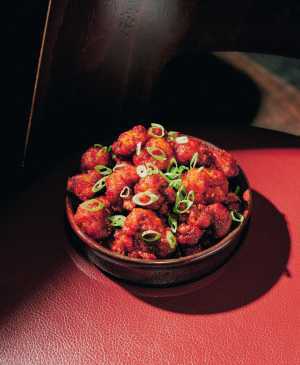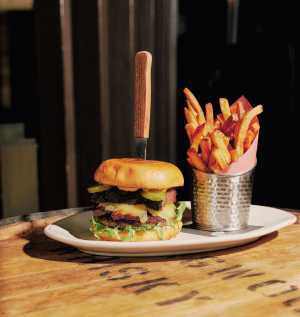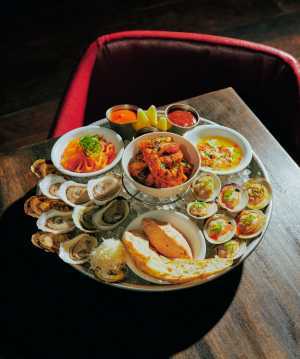Whether you chalk it up to DNA or growing up in a tourist-loving town in the south of France, Yannick Bigourdan was always destined to work in hospitality. The descendant of chefs, restaurateurs and fishmongers, he discovered his passion for restaurants at hotel school before landing in Toronto at Yorkville’s Four Seasons Hotel. Eager to do more, he soon began charming diners with his unique brand of conviviality and refinement at Splendido, Nota Bene and The Carbon Bar — the latter introducing Toronto to Texas-style barbecue in a decidedly Bigourdan way.
In the early aughts, anyone familiar with restaurateur Yannick Bigourdan would have associated the vivacious Frenchman with the finesse of Splendido’s precise tasting menus or Nota Bene’s contemporary Canadian fare, both of which he co-owned with chef David Lee.
“Coming out of Four Seasons, I took over Splendido, transformed it and reopened it,” he explains. “At the beginning, we didn’t have the ambition to create what Splendido became. It was very organic,” he says of the now-shuttered, iconic fine dining restaurant on Harbord Street. “We woke up one day and Splendido had become an institution in the city.”
Yannick Bigourdan, owner of The Carbon Bar
Ashley van der Laan
The only issue? Bigourdan and Lee were not just owners: They became so entwined with the restaurant’s identity that their days off were a terrible blow to diners. “That was a big problem at Splendido. If we were not there, people would say, ‘Oh, that’s a pity’ ... People would always ask for us. ‘Why isn’t David cooking tonight?’” With Nota Bene, the duo hoped for a relaxed environment that would offer more freedom.
Out of that search for independence, The Carbon Bar was born: a spot devoted to Texas-style barbecue. “You’re in the very high-end, very intense cooking experience, creating experiences that are super exclusive. Then, eventually, you say, ‘Hey, maybe I could do a pizza place, or whatever,’ to take away a little bit of the burden that’s on you to be the face of the business all the time.”
Of course, there was also the lure of fall-off-the-bone, slow-smoked meat. “I was exposed to Texas-style barbecue, and I was like, ‘Holy moly. This is absolutely incredible and addictive.’” Taking cues from Austin’s famed Franklin Barbecue, Bigourdan and the team sought to replicate barbecue’s hallowed traditions north of the border, using premium meat, Southern Pride Smokers and white oak, cut and dried to exacting standards. “I was in love with Texas barbecue. Salt, pepper and smoke — that’s basically what it is. We felt that the city was completely missing out on that.”
But any barbecue spot à la Bigourdan was never going to involve wax-paper-lined aluminum serving trays, wooden picnic tables and a rowdy, like-it-or-leave-it mentality. In a lively, modern room designed by Giannone Petricone Associates, diners at The Carbon Bar find themselves staring down St. Louis-style ribs and smoked beef brisket alongside craft cocktails and painstakingly plated dishes of carpaccio, garlic-butter-basted shrimp and fresh fish drizzled with fiery chili oil.
“When we first opened The Carbon Bar, it took about a year for people to understand that we weren’t just a barbecue joint,” says Bigourdan. “They didn’t expect to see a kitchen brigade, with 12 or 14 chefs. Eventually, people realized, it’s everybody’s restaurant.”
Today, Bigourdan’s reach extends from the original restaurant to The Carbon Bar’s online retail store and a new snack- bar concept. He’s also behind Amano Trattoria, The Berczy Tavern and fine-dining newcomer, Lucie — named for his beloved grandmother.
“I realized that I missed having a Lucie in my life — being in that DNA of doing extraordinary things,” he laughs. Are they wildly different ventures? Not to Bigourdan. “When people ask me what it is that I’m looking for in my restaurants, it’s always the same answer: I want to be proud of what we do. That’s it.”
KFC

Ashley van der Laan
“This dish has been a menu staple since day one, handed down from chef to chef. We do florets of cauliflower. They’re blanched and then dredged in seasoned flour and buttermilk, fried, put into the sauce and fried again. It’s quite a process. The interesting thing about that dish is that half the people who eat it think it’s chicken. It’s incredibly surprising.
The profile flavour is very umami; it’s just addictive. It has that sweetness from the gochujang, mirin and rice vinegar. The cauliflower gets very tender. That’s one thing that has never left the menu, nor will it.
Four or five years ago, the price of cauliflower went through the roof. So the kitchen chef said, ‘What are we going to do?’ I said, ‘You can touch a lot, but don’t touch the KFC. Never, ever. It doesn’t matter what the price of the cauliflower is — you don’t touch it.’”
The Carbon Burger

Ashley van der Laan
“Many guests have called this the best burger in the city. One even shouted across our chef’s table that we’d ruined all future burgers for him. It’s another one of those items that has never been tweaked or taken off the menu.
The grind itself is our special recipe. We add brisket fat, rather than just regular beef fat, and brisket meat, as well. Then, you also get a slice of the smoked brisket on top of the patty, which makes it extremely lush. The reaction of people eating that burger is priceless.”
The Pitmaster Platter
Ashley van der Laan
“We wanted to have a very compelling story with our platter — this is the heart of our restaurant and our proudest expression of the craft. It includes our 10-hour, slow-smoked brisket, and the St. Louis-cut ribs, which is important because it’s a meatier cut. It’s a very different experience than the classic baby back ribs.
Then we have the fried chicken, which was probably a year in the making. I remember when we had Nota Bene, and we were thinking about opening The Carbon Bar, I would taste fried chicken, my goodness, three times a week, until we got it right.
Then there’s our hand-cranked jalapeño-cheddar sausage, sweet and spicy pulled pork, coleslaw and pickles. I would say 95 per cent of people never finish the platter because it’s so generous. And we love that. That’s part of the experience.”
Seafood Platter

Ashley van der Laan
“We always had seafood on the menu, but we never put it in a platter format until a year after we opened. People said, ‘Why don’t you do a seafood platter?’ We listened to our clients. We created that, and it’s ever-changing.
There’s always a new recipe on the platter — a new sauce that accompanies the oysters. We try to vary the oysters and we try to exclusively use Canadian products, mainly from the East Coast. We have our famous gravlax. That’s a recipe that we’ve been doing for 11 years. We have a lot of fun with this platter.”
Kentucky Derby Pie
Ashley van der Laan
“When we put a dish on the menu, we always try to make the common denominator the Southern states and barbecue from Texas. If you were to take a survey of what is the most iconic dessert, I bet that 80 per cent of people would come back with key lime pie and the Kentucky Derby pie.
We started experimenting with it, and I got completely obsessed with it. It’s a traditional recipe made with corn syrup, butter, eggs, pecans, chocolate and bourbon. We use puff pastry for the base and top it with Madagascar vanilla bean Chantilly cream.
We put it on the menu, and we weren’t sure if it would stay. It’s very sweet, and we thought it might be too big a dessert after a big platter of barbecue. But then, we took it off the menu for six months, and had not complaints, so much as constructive criticism. So it had to come back.”
